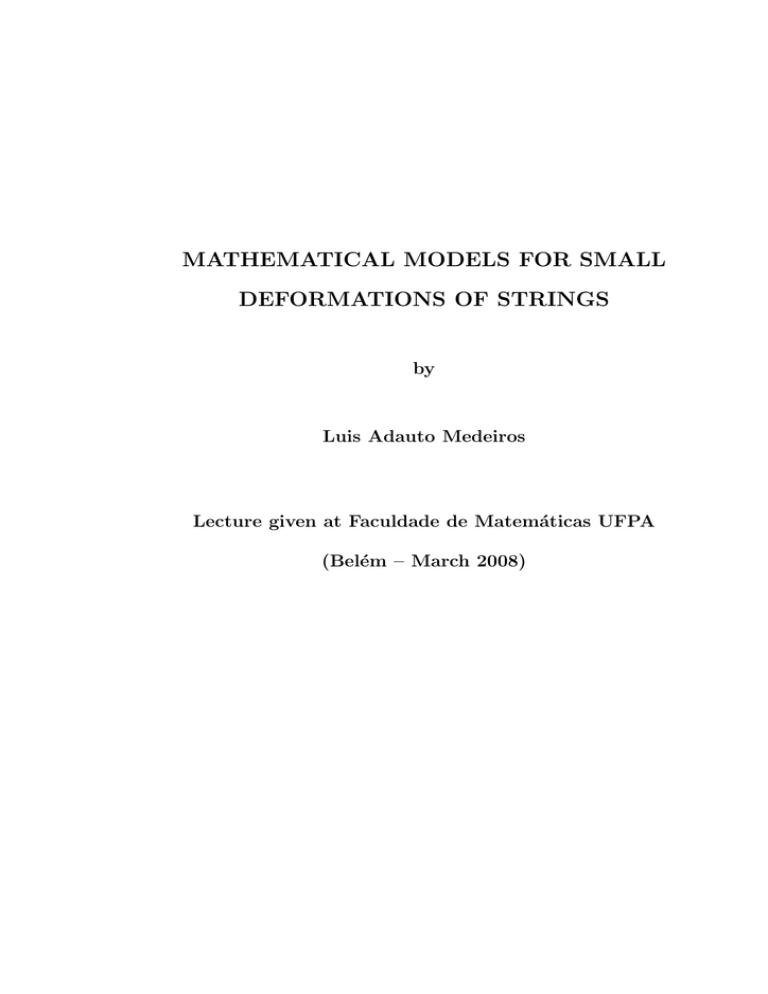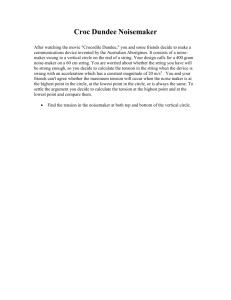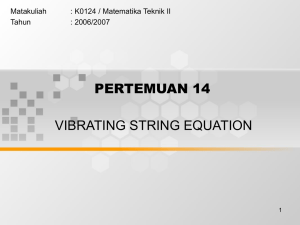mathematical models - Instituto de Matemática
advertisement

MATHEMATICAL MODELS FOR SMALL
DEFORMATIONS OF STRINGS
by
Luis Adauto Medeiros
Lecture given at Faculdade de Matemáticas UFPA
(Belém – March 2008)
FIXED ENDS
Let us consider a stretched string which in rest position is represented
by the segment [α0 , β0 ] in the x-axis of an orthogonal system of coordenate
in a plane x0u, with 0 < α0 < β0 . We suppose small vibrations and the
vibrations on the plane x0u, which we call vertical vibrations or vertical
deformations of the string.
We suppose τ0 the tension in the string at rest position [α0 , β0 ], that is,
τ0 is the force per unite of area of the cross section of the string. At time
t > 0 the point (x, t), α0 < x < β0 , of the string, belongs to a plane curve
Γ(t) which equation is u = u(x, t). The tension is variable and at Γ(t) it
is τ , which is the force by unit of area of the cross section of Γ(t). The
tension is a vector ~τ with modulus τ . Let be γ0 = β0 − α0 and S the lenght
of the curve deformation Γ(t) at time t. The variation of the tension is
τ − τ0 and the variation of the lenght of deformation is (S − γ0 ) γ0 , the
mean deformation. The Hooke’s law says that τ − τ0 is a linear function
of (S − γ0 ) γ0 , that is
S − γ0
·
(1.1)
τ − τ0 = k
γ0
In general k is constant when the string is homogeneous, that is, its density,
mass per unit of lenght, is constant. Suppose that it is not homogeneous,
that is, k depends of α0 < x < β0 and of the time t > 0. Thus the Hooke’s
law is
τ − τ0 = k(x, t)
1
S − γ0
γ0
(1.2)
u
(t)
u (x,t)
0
x
x
0
0
Figure 1
The tension τ in the point (x, u), of the deformation curve Γ(t), is a
vector ~τ which has the direction of the tangent to Γ(t), at the point (x, u),
with modulus τ . We suppose Γ(t) regular and Γ(α0 ) = Γ(β0 ) = 0, the
string has fixed ends. See Fig. 1.
Let θ be the angle of the direction 0x with the vector ~τ . The components
of ~τ are:
τ sen θ
and
τ cos θ.
(1.3)
By hypothesis we have small vertical deformations of the string [α0 , β0 ].
Thus, we don’t need to consider the horizontal component, τ cos θ, which
is “very small”. Thus we don’t consider, in the present argument, the
horizontal component of ~τ .
Let d(x, t) be the density of the string at points x at time t, that is the
mass per unity of length. The variations of the tension ~τ gives origin to a
force on Γ(t) and, by Newton’s law, we have:
∂u
∂
∂
γ0 d(x, t)
=
(τ sen θ) ,
∂t
∂t
∂x
2
(1.4)
γ0 d(x, t) is the mass of the string.
We supposed small vibrations or small deformations what means that
the gradient of deformations is small, that is, we must have:
∂u ≪ 1.
∂x (1.5)
∂u
·
∂x
From (1.2), the material is non homogeneous, the tension τ −τ0 depends
As a consequence of (1.5) we have sen θ ≈ tg θ =
on x, t. We obtain, from (1.4)
∂
∂τ
∂ sen θ
(τ sen θ) =
sen θ + τ
,
∂x
∂x
∂x
or
∂τ ∂u
∂ 2u
∂
(τ sen θ) =
+τ 2·
∂x
∂x ∂x
∂x
Analysis of
(1.6)
∂τ
∂x
In fact, the length of the arc Γ(t) is
s
2
Z β0
∂u
S=
dx.
1+
∂x
α0
(1.7)
From the hypothesis (1.5) it follows that the series representation for
q
2
the function 1 + ∂u
dx is uniformly convergent. Then it is reasonable
∂x
to consider the approximation
s
2
2
1 ∂u
∂u
1+
≈1+
.
∂x
2 ∂x
3
Then, from (1.7), we obtain
Z
S=
β0
α0
"
1
1+
2
∂u
∂x
2 #
Z
∂u
∂x
2
or
1
S − γ0 =
2
From(1.2) and (1.8) we have
β0
α0
k(x, t)
τ − τ0 =
2γ0
Z
then
∂τ
1 ∂k(x, t)
=
∂x 2γ0 ∂x
β0
α0
Z
β0
α0
∂u
∂x
dx
2
∂u
∂x
(1.8)
dx.
dx,
2
dx.
From (1.6) and (1.10) we get
"
Z β0 2 #
1 ∂k(x, t)
∂u
∂u
∂
(τ sen θ) =
+
dx
∂x
2γ0 ∂x
∂x
∂x
α0
"
Z β0 2 # 2
∂u
k(x, t)
∂ u
+ τ0 +
dx
2γ0 α0 ∂x
∂x2
(1.9)
(1.10)
(1.11)
Substituting (1.11) in (1.4) we get the partial differential equation:
"
Z β0 2 #
∂
1 ∂k(x, t)
∂u
∂u
∂u
−
γ0 d(x, t)
−
dx
∂t
∂t
2γ0 ∂x
∂x
∂x
α0
"
Z β0 2 # 2
∂u
k(x, t)
∂ u
= 0.
(1.12)
− τ0 +
dx
2γ0 α0 ∂x
∂x2
Thus, (1.12) is the mathematical model for the physical problem of
small vertical vibrations of a stretched string fixed at the ends (α0 , 0),
(β0 , 0), when the material of the string is not homogeneous.
4
We change the notation in order to formulate the mathematical problem
for (1.12). In fact, set
γ0 d(x, t) = ρ(x, t), with ρ(x, t) ≥ ρ0 > 0
k(x, t)
M (x, t, λ) = τ0 +
λ
2γ
0
N (x, t, λ) = 1 ∂ k(x, t) λ = ∂ M (x, t, λ).
2γ0 ∂x
∂x
Thus the model (1.12) can be written in the form:
Z β0 2 ! 2
∂u
∂u
∂ u
∂
−
ρ(x, t)
− M x, t,
dx
∂t
∂t
∂x
∂x2
α0
Z β0 2 !
∂u
∂u
= 0.
− N x, t,
dx
∂x
∂x
α0
(1.13)
(1.14)
Particular Cases
• Suppose the material of the string is homogeneous, that is, k(x, t) = k
∂k
constant for α0 ≤ x ≤ β0 and t ≥ 0. Thus
= 0, k is constant with
∂x
respect to x and we suppose it is also constant with respect to t. The
density d(x, t) is also constant and we represent d(x, t)γ0 by the constant
ρ. The model (1.12) reduces to
"
Z β0 2 # 2
∂u
∂ u
k
∂ 2u
dx
= 0.
ρ 2 − τ0 +
∂t
2γ0 α0 ∂x
∂x2
(1.15)
This model was obtained by G. KIRCHHOFF – Vorlesungen über mechanik, Tauber - Leipzig 1883. It is called Kirchhoff’s model.
5
To observe that in the Kirchhoff’s model the string is homogeneous but
the tension is variable, with the time, that is, by (1.9) the tension at time
t is given by
k
τ (t) = τ0 +
2γ0
Z
β0
α0
∂u
∂x
2
dx,
(1.16)
where τ0 is the tension of the string [α0 , β0 ] in the rest position. The term
Z β0 2
∂u
k
dx
(1.17)
2γ0 α0 ∂x
is the contribution when the tension is variable.
• Suppose now we have homogeneous material and the tension a constant τ0 , for each time t. In this case, we have not the contribution (1.17)
and τ = τ0 for all t. The model (1.15) of Kirchhoff reduces to
∂ 2u
∂ 2u
ρ 2 − τ0 2 = 0
∂t
∂x
(1.18)
2
∂ 2u
2 ∂ u
=C
,
∂t2
∂x2
(1.19)
or
τ0
·
ρ
The model (1.19) was obtained by Jean D’Alembert in 1741, cf. J.
C2 =
D’ALEMBERT – Recherches sur les vibrations des cordes sonores - Opuscules Mathématiques, Tome Premier (1741) pp. 1-65 - Acad. Fran. des
Sciences, Paris, France.
We could say that (1.19) was the first partial differential equation describing problems of physics.
6
The method above developed is when the string has fixed ends (α0 , 0),
(β0 , 0).
Suppose the ends of the string are variable. Let us consider the case
homogeneous.
VARIABLE ENDS
We suppose the homogeneous case but with variable tension. We consider the ends variable with t > 0, that is,
0 < α(t) ≤ α0 < x < β0 ≤ β(t).
At time t > 0 we represent the string by [α(t), β(t)], with α(0) = α0 ,
β(0) = β0 , see Figure 2. Thus, the lenght of the string is γ(t) = β(t) − α(t)
at t > 0 and γ0 = β0 − α0 at t = 0.
u
parallel to 0 x
(t)
0
(t)
x
0
0
(t)
x
Figure 2
We employ the notation:
τ0 the tension at [α0 , β0 ], rest position.
~τ (t) vector tension at the curve Γ(t), deformation of [α(t), β(t)], at
time t.
7
τ (t) modulus of the vector ~τ (t) which has the direction of the tangent vector at Γ(t).
t > 0.
τb(t) tension in the deformation [α(t), β(t)] of [α0 , β0 ] at the time
The components of ~τ (t) at time t, are:
τ (t) sen θ
vertical
τ (t) cos θ
horizontal
By θ we represent the angle of the direction 0x with the tangent vector
to Γ(t) at time t, as in Figure 2.
By u(x, t) we represent the deformations at time t of x in [α(t), β(t)].
By hypothesis of small deformations we consider only the vertical component.
The variations of this component are
∂
(τ (t) sen θ) and, by Newton’s
∂x
law, we have:
∂
∂ 2u
(τ (t) sen θ) = m 2
∂x
∂t
(1.20)
m the mass of the string. We suppose the deformations are very small so
that the density of [α0 , β0 ], [α(t), β(t)], Γ(t) are approximately the same.
Thus m = ρ γ0 is constant.
Analysis of the tension τ (t).
By Hooke’s law we obtain:
8
• deformation of [α0 , β0 ] into [α(t), β(t)]
τb(t) − τ0 = k
γ(t) − γ0
γ0
(1.21)
• deformation of [α(t), β(t)] into Γ(t)
τ (t) − τb(t) = k
S(t) − γ(t)
,
γ(t)
(1.22)
S(t) is the lenght of the curve Γ(t).
We know that
s
2
∂u
dx =
S(t) =
1+
∂x
α(t)
2 #
Z β(t) "
1 ∂u
=
1+
dx =
2
∂x
α(t)
2
Z
1 β(t) ∂u
= γ(t) +
dx.
2 α(t) ∂x
Z
β(t)
This approximation can be done because it is
supposed small deformation,
∂u that is, small gradient of deformations, ≪ 1.
∂x
Thus, we have
2
Z
1 β(t) ∂u
dx.
(1.23)
S(t) − γ(t) =
2 α(t) ∂x
Substituting (1.23) in (1.22) we obtain:
Z β(t) 2
k
∂u
τ (t) − τb(t) =
dx.
2γ(t) α(t) ∂x
(1.24)
From (1.21) and (1.24) we obtain the tension τ (t) on Γ(t) given by:
Z β(t) 2
1
γ(t) − γ0
∂u
+
τ (t) = τ0 + k
dx.
(1.25)
γ0
2γ(t) α(t) ∂x
9
We go back to the equilibrium equation (1.20) we have
∂
∂
∂
∂ 2u
(τ (t) sen θ) = τ (t)
sen θ = τ (t)
tg θ = τ (t) 2
∂x
∂x
∂x
∂x
and substituting in (1.20) we obtain
∂ 2u
∂ 2u
m 2 = τ (t) 2 ·
∂t
∂x
(1.26)
By (1.25) and (1.26) we have the mathematical model when the ends
are moving
"
Z β(t) 2 # 2
2
τ0
1
k
∂u
po u
∂ u
+
γ(t)
−
γ
−
= 0.
+
dx
0
∂t2
m mν0
2mν(t) α(t) ∂x
∂t2
(1.27)
Thus, (1.27) is the mathematical model for vertical vibrations of a stretched string, homogeneous, when the ends are variable with the time t and
variable tension.
Particular Cases
• If α(t) = α0 , β(t) = β0 , for all t > 0, we have γ(t) = γ0 , t ≥ 0, then
(1.27) reduces to
2
"
∂ u
τ0
1
−
+
∂t2
m 2mν0
Z
β0
α0
∂u
∂x
2
#
∂ 2u
dx
= 0,
∂x2
which is the KIRCHHOFF model.
• If the tension is constant, τ (t) = τ0 for all t > 0, the perturbation in
Kirchhoff’s model is zero and we have
∂ 2 u τ0 ∂ 2 u
−
= 0,
∂t2
m ∂x2
10
which is the D’ALEMBERT’s model.
We acknowledge Professor I-Shih Liu of IM-UFRJ for stimulating conversations when we investigated the variable ends.
MATHEMATICAL PROBLEMS
When we deduce mathematical models, from physical phenomenon, we
usually consider many approximations. Thus, we must formulate certains
mathematical problems about the model and prove that these mathematical problems formulated are well posed in the sense of JACQUES HADAMARD. It means that the problem has a non trivial solution, this solutions is unique and it depends continuously of the datum of the problem.
Otherwise, the problem is called non well posed. In the following we will
propose, for the models obtained above, same well posed problem. For
τ0
example, let us fixe our attention for D’Alembert (1.18). Set C 2 =
as
ρ
was done.
Initial Boundary Value Problem. Find u(x, t), from α0 < x < β0 ,
0 < t < T , T > 0, into the real numbers R, satisfying:
2
2
∂ u
2 ∂ u
∂t2 − C ∂x2 = 0 in α0 < x < β0 , 0 < t < T, T > 0
u(α0 , t) = u(β0 , t) = 0 for 0 < t < T
∂u
(x, 0) = u1 (x) α0 > x < β0
u(x, 0) = u0 (x),
∂t
(1.28)
The condition (1.28)2 says that the string has fixed ends. The (1.28)3 gives
∂u
(x, 0). They
conditions on the rest position u(x, 0) and initial velocity
∂t
are known function u0 (x) and u1 (x). With convenient choice of u0 , u1 we
11
can prove that the boundary value problem (1.28) is well posed.
Cauchy Problem. It consists to investigate the well poseness of the problem – find u(x, t), but for −∞ < x < +∞, and 0 < t < ∞, solution of
the initial value problem
2
2
∂ u
2 ∂ u
∂t2 − C ∂x2 = 0 for − ∞ < x < +∞, t > 0
∂u
u(x, 0) = u0 (x),
(x, 0) = u1 (t), −∞ < x < +∞.
∂t
(1.29)
Let us remember how D’Alembert solved the equation
∂ 2u ∂ 2u
= 2
∂t2
∂x
when we set C = 1. He wrote
∂ ∂u
∂ ∂u
=
.
∂t ∂t
∂x ∂x
We look for u(x, t), α0 ≤ x ≤ β0 , 0 ≤ t ≤ T and we suppose it regular.
Thus, its differential du is given by:
du = q dt + p dx,
with
q=
∂u
∂t
and p =
Now let us consider the differential form
w = p dt + q dx,
12
∂u
·
∂x
with p =
∂u
∂u
, q=
, u solution of D’Alembert equation, that is,
∂x
∂t
∂ ∂u
∂ ∂u
=
∂x ∂x
∂t ∂t
or
∂
∂
p=
q,
∂x
∂t
what says that w is a exact differential form. Then w is a differential of a
function v(x, t), that is,
d v = p dt + q dx.
We obtain
d(u + v) = (p + q)d(x + t)
d(u − v) = (p − q)d(x − t)
Then D’Alembert says that
u + v = φ(x + t)
u − v = ψ(x − t).
Thus the solution u(x, t) of the equation is
u(x, t) =
1
[φ(x + t) + ψ(x − t)]
2
(1.30)
φ, ψ “arbitrary” function, second D’Alembert.
The solution of the Cauchy problem (1.29) is
Z
1 x+t
1
u1 (s) ds.
u(x, t) = [u0 (x + t) + u0 (x − t)] +
2
2 x−t
13
(1.31)
For details, we can see L.A. Medeiros - N.G. Andrade - Iniciação às
Equações Diferenciais Parciais, LTC, Rio de Janeiro, RJ, 1978.
Now, we propose the problems (1.28), initial boundary value problem,
and (1.29), Cauchy problem, for Kirchhoff’s operator, for the case of fixed
ends.
Initial Boundary Value Problem. Find u(x, t) from α0 < x < β0 ,
0 < t < T , T > 0, to the real numbers R, satisfying:
"
Z β0 2 # 2
∂ 2u
τ0
∂ u
∂u
k
+
dx
=0
2 −
∂t
ρ
2ργ0 α0 ∂x
∂x2
in α < x < β , 0 < t < T, T > 0
0
0
u(α0 , t) = u(β0 , t) = 0 for 0 ≤ t ≤ T
u(x, 0) = u (x), ∂u (x, 0) = u (x), α < x < β .
1
0
0
0
∂t
(1.32)
The boundary value problem (1.32) is non linear and consequently we
have not chance to obtain solutions as for (1.28). The technique to solve
the problem (1.32) is more elaborate. In general, we obtain local solution
in t, that is, there exists T0 > 0 so that the solution exists on [0, T0 ). The
technique of weak solutions applying Sobolev’s spaces is employed.
Cauchy Problem. It consists to find u(x, t),
∞ < x < +∞,
0<t<
∞ with values in the real numbers, solution of the initial value problem
14
2
∂ u
−
∂t2
for
τ0
k
+
ρ
2ργ0
Z
+∞ −∞
− ∞ < x < +∞,
u(x, 0) = u0 (x),
∂u
∂x
2
dx
!
∂ 2u
=0
∂x2
(1.33)
t>0
∂u
(x, 0) = u1 (x),
∂t
−∞ < x < +∞.
This is a problem formulated in the unbounded domain −∞ < x < +∞,
0 < t < ∞. The problem (1.32) is formulated in the bounded domain
α0 < x < β0 ,
0 < t < T . When we investigate (1.32) and (1.33) by
techniques of functional analysis, we have compactness in (1.32) but not
in (1.33). This make a difference in the methods in classical analysis, in
the basic courses of partial differential equation. We employ Fourier series
in the bounded domain and Fourier transforms in the Cauchy problem.
The nonlinear boundary value and Cauchy problem, respectively (1.32)
and (1.33), can be formulated in general. Let us formulate the initial
boundary value problem (1.32). In fact, let Ω be a bounded open set of Rn
with boundary Γ, regular. The nonlinearity we represent by M (λ). Here
τ0
k
is a generalization of
λ which, by hypothesis, does not depends
+
ρ
2ρν0
of x and t. We consider the cylinder Q = Ω × (0, T ), T > 0, with lateral
boundary Σ = Γ × (0, T ). A point of Rn is represented by x = (x1 , . . . , xn )
with xi real numbers. Thus, we look for a real function u(x, t), (x, t) ∈ Q
solution of
15
∂ 2u
−M
∂t2
Z
|∇u(x, t)|2 dx ∆u = f
Ω
in Q
u = 0 on Σ,
(1.34)
∂u
(x, 0) = u1 (x), x ∈ Ω.
∂t
We represent by ∆ an ∇, respectively the Laplace operator in Rn and
the gradient.
u(x, 0) = u0 (x),
The Cauchy problem in this general case is formulate as (1.32).
For results and abstract formulation of this problem, see: J.L. LIONS On some questions in boundary value problems of mathematical physics Contemporary developments in continuum mechanics and partial differential equations - ed. M. de La Penha and L.A. Medeiros, North Holland,
Amsterdam, (1978), pp. 285-346.
Variable Ends
Now let us consider the Kirchhoff’s model (1.27) when the ends of the
string move with the time, that is
"
Z β(t) 2 # 2
2
τ0
1
k γ(t) − γ0
∂u
∂ u
∂ u
+
−
= 0.
+
dx
∂t2
m m
γ0
2mγ(t) α(t) ∂x
∂x2
We have 0 < α(t) < β(t), γ(t) = β(t)−α(t) and γ0 = β0 −α0 , α0 = α(0),
β0 = β(0).
b the noncylindrical domain Q
b = {(x, t) ∈ R2 ; α(t) < x <
Let us define Q
b is
β(t), for 0 < t < T }. The boundary of Q
[ b=
(α(t), β(t), t .
Σ
0<t<T
16
Set
τ0
k γ(t) − γ0
,
+
m m
γ0
k
b(t) =
,
2mγ(t)
a(t) =
and
"
Z β(t) 2 # 2
2
∂
u
∂ u
∂u
b u(x, t) =
L
dx
−
a(t)
+
b(t)
·
∂t2
∂x
∂x2
α(t)
b
We propose the following boundary value problem for L.
b solution of
Find the real function u(x, t) for (x, t) ∈ Q
b
b
Lu(x, t) = f (x, t) in Q,
b
u(x, t) = 0 for (x, t) ∈ Σ
∂u
u(x, 0) = u0 (x),
(x, 0) = u1 (x) for α0 < x < β0 .
∂t
(1.35)
With convenient hypothesis on α(t), β(t), u0 , u1 , f we prove existence
and uniqueness for (1.35), cf. L.A. Medeiros-J. Limaco-S.B. Menezes, Vibrations of Elastic Strings: Mathematical Aspects, J. of Computational
Analysis and Applications, V.4, No¯ 2, (April 2002), Part One, pp. 91-127
and Vol. 4, No¯ 3, (July 2002) Part Two, pp. 211-263.
About the model (1.14) can also be formulated as (1.32). For some
results see: Tania Rabello, Maria Cristina Vieira, L.A. Medeiros, On a
Perturbation of Kirchhoff Operator (submited for publication).
17
INEQUALITIES
We also can formulate inequalities instead of equalities for the Kirchhoff’s operator or for D’Alembert operator. We consider the case of
variable ends. In fact, let us consider the notation of the initial boundary
value problem (1.35).
b → R solution of
We want to find u(x, t), u : Q
b
b
Lu(x, t) ≥ f (x, t) in Q
b
u(x, t) = 0 on Σ
∂u
u(x, 0) = u0 (x),
(x, o) = u1 (x), in (α0 , β0 )
∂t
(1.36)
In this case we consider the convex set Kt defined, for t > 0, by
∂w
1
Kt = w ∈ H01 (Ωt ). ≤
a.e. in Ωt .
∂x
γ(t)
To observe that H01 (Ωt ) is the Sobolev space on Ωt , Ωt = (α(t), β(t)) a
b at level t > 0. Thus, Kt is a convex set of H01 (Ωt ).
section of Q
With the definition of solution for (1.36), we prove that with the choice
u0 ∈ H01 (Ω0 ) ∩ H 2 (Ω),
u1 ∈ Kt ⊂ H01 (Ω)
and a convenient f , we obtain a solution unique, for (1.36) defined for all
b
(x, t) ∈ Q.
Remark 1. It is interesting to observe that the solution (1.35), also in the
cylindrical case, there exists for 0 < t < T0 < T , called local solution. To
18
obtain a global solution it is necessary to consider initial data u0 , u1 with
restrictions on their norms. Note that in the inequality (1.36) we obtain
solution for all t > 0 with less restriction on the initial data. For detail
see:
M.D.G. da Silva - L.A. Medeiros - A.C. Biazutti - Vibrations of Elastic
Strings: Unilateral Problem - J. of Compt. Analysis and Applications, Vol.
8, No¯ 1 (2006), pp. 53-73.
19



